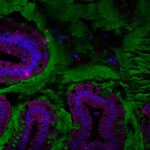Link to Pubmed [PMID] – 34628447
Link to DOI – 10.1249/MSS.0000000000002809
Med Sci Sports Exerc 2022 Mar; 54(3): 517-529
Menopause tends to be associated with an increased risk of obesity and abdominal fat mass (FM) and is associated with lower intestinal species diversity. The aim of this study was to determine the effects of a high-intensity interval training and resistance training (HIIT + RT) program on body composition and intestinal microbiota composition in overweight or obese postmenopausal women.Participants (n = 17) were randomized in two groups: HIIT + RT group (3× per week, 12 wk) and control group without any training. Dual-energy x-ray absorptiometry was used to measure whole-body and abdominal/visceral FM and fat-free mass. Intestinal microbiota composition was determined by 16S rRNA gene sequencing at baseline and at the study end, and the diet was controlled.Compared with sedentary controls, physical fitness (maximal oxygen consumption, peak power output) increased, total abdominal and visceral FM decreased, and segmental muscle mass increased in the training group. Although the HIIT + RT protocol did not modify α-diversity and taxonomy, it significantly influenced microbiota composition. Moreover, various intestinal microbiota members were correlated with HIIT + RT-induced body composition changes, and baseline microbiota composition predicted the response to the HIIT + RT program.HIIT + RT is an effective modality to reduce abdominal/visceral FM and improve physical capacity in nondieting overweight or obese postmenopausal women. Training modified intestinal microbiota composition, and the response to training seems to depend on the initial microbiota profile. More studies are needed to determine whether microbiota composition could predict the individual training response.


